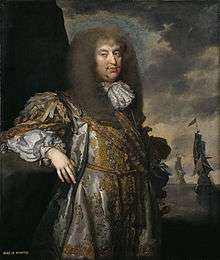Henry Howard, 7th Duke of Norfolk
Henry Howard, 7th Duke of Norfolk, KG PC Earl Marshal (11 January 1655 – 2 April 1701) was an English nobleman, politician, and soldier. He was the son of Henry Howard, 6th Duke of Norfolk and Lady Anne Somerset, daughter of Edward Somerset, 2nd Marquess of Worcester and Elizabeth Dormer. He was summoned to the House of Lords in his own right as Baron Mowbray in 1678. His unhappy marriage was a subject of much gossip, and ended in divorce.
Henry Howard | |
|---|---|
| Duke of Norfolk | |
 | |
| Born | 11 January 1655 |
| Died | 2 April 1701 (aged 46) Norfolk House, London, England |
| Buried | 8 April 1701 Arundel Castle, Arundel, West Sussex |
| Noble family | Howard |
| Spouse(s) | Mary Mordaunt |
| Father | Henry Howard, 6th Duke of Norfolk |
| Mother | Anne Somerset |

Marriage, separation and divorce
He married Mary Mordaunt, the only surviving daughter and heiress of the 2nd Earl of Peterborough and Penelope O'Brien. They separated in 1685. He divorced her for her adultery with Sir John Germain in 1700, after a previous attempt at divorce in 1692 had failed when the House of Lords threw out his private Divorce Bill. Although he succeeded in obtaining damages in an action for criminal conversation, the details were so sordid that he may well have regretted the step, especially since the jury reduced his claim for £100,000 damages to £66, for which they were severely reprimanded by the presiding judge. The Duke was evidently in no position to condemn his wife's conduct: even his own counsel called it frankly a case of the pot calling the kettle black.
He died without children, and was succeeded by his nephew, Thomas Howard, 8th Duke of Norfolk. His former wife married secondly Sir John Germain, 1st Baronet, who had been her lover for many years. She died in 1705.
He was rarely on good terms with his father, particularly after 1677 when his father married Jane Bickerton, his mistress of many years standing, an act which caused a violent family quarrel.[1]
Later life
Like almost all the Howards of Norfolk he was a devout Roman Catholic; but during the anti-Catholic hysteria engendered by the Popish Plot he publicly conformed to the Church of England.[2] There is little doubt that this was simply a device to save the family estates. The ploy seems to have succeeded; although his father was charged with recusancy in 1680, the charge was quickly dropped. While the senior Howard line survived unscathed, their cousin William Howard, 1st Viscount Stafford, was executed for his supposed part in the Plot in December 1680.[3] Henry as a peer in his own right, Baron Mowbray, sat as one of the peers who tried him. It is a sign of his moral courage and independent judgment, given the anti-Catholic feeling in the country, that he voted Not Guilty. This was the more notable since according to John Evelyn, of Stafford's extended family in the House of Lords, (eight of them in all), he was the only one to do so, Stafford being a man "not beloved by his family".[4]
He became a Fellow of the Royal Society in 1672. His father was already a fellow and was a generous benefactor of the Society.
On 20 June 1685, he was appointed Colonel of the Suffolk Regiment, which at the time was called the Duke of Norfolk's Regiment of Foot. He was created a Knight of the Garter in the same year. As a man "all-powerful in his Dukedom"[5] he used his influence in the 1685 General Election to return members entirely loyal to the Crown (as his father had in 1673 when he found a safe seat at Castle Rising for Samuel Pepys). By 1688, however, he was on bad terms with James II, openly disapproving of the King's aggressive policy of Catholic championship. When asked to question his constituents on whether they favoured repeal of the Test Act, he replied bluntly that he knew that all those in favour of repeal would fit comfortably in one coach.[6] When asked to replace the magistrates in his dukedom with more compliant ones he simply refused and prudently went to France,[7] but returned in time to welcome the Glorious Revolution.
The first HMS Norfolk was named after him.
He served as a Privy Councillor under William III and Mary II in 1689. At first, he refused to take the oath necessary to sit in the House of Lords, since although he had publicly conformed to the Anglican rite, it was no secret that he remained a Roman Catholic at heart; but after a few months he subscribed to the oath.
His private surgeon was Thomas Greenhill.
Death
A written account of the death of the 7th Duke of Norfolk, who died in London on Wednesday (O.S.) the 2d of April 1701 by his secretary Francis Negus.
Aprill ye 3rd 1701
Sir,
My Lord Duke died suddendly yesterday about eleven of the clock. His body was opened this night and all parts well, but destroyed with coagulated blood.
Sir, Your afflicted humble servant.
ffr. Negus
For Mr Edward L'Estrange at Mileham Norfolke
— Norfolk lieutenancy journal, 1676-1701, transcribed and edited by Basil Cozens-Hardy, Norfolk Record Society, 1961.
Ancestry
| Ancestors of Henry Howard, 7th Duke of Norfolk | |||||||||||||||||||||||||||||||||||||||||||||||||||||||||||||||||||||||||||||||||||||||||||||||||||||||||||||||||||||||||||||||||||||||||||||||||||||||||||||||||||||||||||||||||||||||||||||||||||||||||||||||||||||||||||||||||||||||||||||||||||||||||||||||||||||||||||||||||||||||||
|---|---|---|---|---|---|---|---|---|---|---|---|---|---|---|---|---|---|---|---|---|---|---|---|---|---|---|---|---|---|---|---|---|---|---|---|---|---|---|---|---|---|---|---|---|---|---|---|---|---|---|---|---|---|---|---|---|---|---|---|---|---|---|---|---|---|---|---|---|---|---|---|---|---|---|---|---|---|---|---|---|---|---|---|---|---|---|---|---|---|---|---|---|---|---|---|---|---|---|---|---|---|---|---|---|---|---|---|---|---|---|---|---|---|---|---|---|---|---|---|---|---|---|---|---|---|---|---|---|---|---|---|---|---|---|---|---|---|---|---|---|---|---|---|---|---|---|---|---|---|---|---|---|---|---|---|---|---|---|---|---|---|---|---|---|---|---|---|---|---|---|---|---|---|---|---|---|---|---|---|---|---|---|---|---|---|---|---|---|---|---|---|---|---|---|---|---|---|---|---|---|---|---|---|---|---|---|---|---|---|---|---|---|---|---|---|---|---|---|---|---|---|---|---|---|---|---|---|---|---|---|---|---|---|---|---|---|---|---|---|---|---|---|---|---|---|---|---|---|---|---|---|---|---|---|---|---|---|---|---|---|---|---|---|---|---|---|---|---|---|---|---|---|---|---|---|---|---|---|---|---|---|
| |||||||||||||||||||||||||||||||||||||||||||||||||||||||||||||||||||||||||||||||||||||||||||||||||||||||||||||||||||||||||||||||||||||||||||||||||||||||||||||||||||||||||||||||||||||||||||||||||||||||||||||||||||||||||||||||||||||||||||||||||||||||||||||||||||||||||||||||||||||||||
References
- Kenyon, J.P. The Popish Plot Phoenix Press Reissue 2000 p. 35
- Kenyon p.35
- Kenyon p.232
- Evelyn Diary 7 December 1680
- Kenyon, J.P. The Stuart Constitution 2nd Edition Cambridge University Press p.447
- Kenyon, J.P. Robert Spencer, 2nd Earl of Sunderland 1641-1702 Longman Greens London 1958 p.173
- Kenyon Stuart Constitution p.464
See also
- Dukes of Norfolk family tree
- . Dictionary of National Biography. London: Smith, Elder & Co. 1885–1900.
- List of deserters from James II to William of Orange